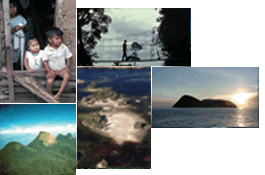Base Layers
The Base Layers include 2 raster images and 4 polygon or point layers. Raster images can only be visualized one at a time and must be the bottom layer. You can overlay protected area or other vector information on top of them. You cannot modify the way a raster image is rendered but you can control a point or polygon layer colors, width and fill pattern (please see the tutorial).
Given the complexity and size of the elevation, hidrology and roads coverages, these were used to create two raster images at 1Km resolution. One image includes elevation and hidrology, the other one includes national boundaries and the road network.
Elevation and Rivers. Elevation image is derived from The Global Land One-km Base Elevation (GLOBE) Project data, classified by 500m contour intervals. Hydrography is data derived from ESRI's ArcWorld™ 1:3 M dataset, perennial lakes and rivers data. Both datasets were overlayed and rasterized to 1 KM resolution.
GLOBE Task Team and others (Hastings, David A., Paula K. Dunbar, Gerald M. Elphingstone, Mark Bootz, Hiroshi Murakami, Hiroshi Maruyama, Hiroshi Masaharu, Peter Holland, John Payne, Nevin A. Bryant, Thomas L. Logan, J.-P. Muller, Gunter Schreier, and John S. MacDonald), eds., 1999. The Global Land One-kilometer Base Elevation (GLOBE) Digital Elevation Model, Version 1.0. National Oceanic and Atmospheric Administration, National Geophysical Data Center, 325 Broadway, Boulder, Colorado 80303, U.S.A. Digital data base on the World Wide Web (URL: http://www.ngdc.noaa.gov/seg/topo/globe.shtml) and CD-ROMs.
Environmental Systems Research Institute. ArcWorld™ 1:3M. [machine readable data file]. ArcView™ format. Redlands, CA: Environmental Systems Research Institute, [1999].
Country Borders, Roads, Major Cities and Populated Places are from VMAP0 (Digital Chart of the World):
National Imagery and Mapping Agency, VMAP_1V10 - Vector Map Level 0 (Digital Chart of the World), Fairfax, VA, Digital data base on the World Wide Web (URL: http://geoengine.nima.mil/), downloaded May, 2002.
